NORTH WALES COAST RAILWAY:NOTICE
BOARD
Rheilffordd arfordir gogledd Cymru: Hysbysfwrdd
20 February 2012
 Last issue
Last issue Archive
Archive Contributions and comments are encouraged: see the Contributions Page
This site is dedicated to all our regular contributors and supporters, and especially the rail staff of North Wales.
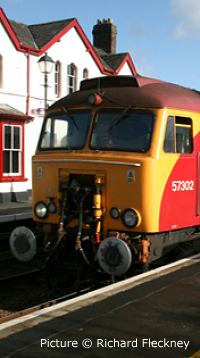
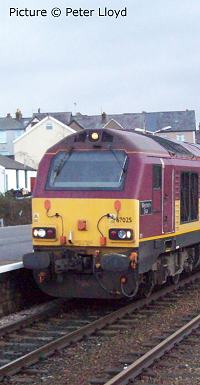
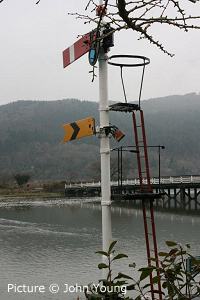
Forthcoming events
February 2012
Thursday 23 February Merseyside Railway History Group Graham Briggs: Steaming Through Britain
Wednesday 29 February Ffestiniog Railway Society Dee & Mersey Group. Operating a 40 mile railway. Phil Brown.
March 2012
Friday 2 March Clwyd Railway Circle AGM followed by Photo Competition and Members Night. Members are invited to give a 15 minute presentation of their choice, any format welcomed. Please book your slot no later than 17th February by contacting David Jones.
Thursday 8 March Llandudno and Conwy Valley Railway Society Geoff Morris "30 years west of Swansea"
Friday 9 March Altrincham Electric Railway Preservation Society "The Railways of the Peak District" by Dr Les Nixon
Monday 12 March. Wrexham Railway Society Vintage Steam Film Show - Colin White presents a selection of 8mm cine films with his unique commentary about the abilities of the loco crews in the 1860s.
Tuesday 13 March 8E Railway Association Geoff Coward presents Back To The 60's
Saturday 17 March Stephenson Locomotive Society Ken Grainger Rhapsody in Blue – The Great Northern Railway of Ireland. A whistle-stop tour, in colour, of the Great Northern network, mainly by steam but also including not unattractive diesel railcars and delightful half-cab railbuses, as well as the Hill of Howth open-top electric trams and not forgetting the immortal horse-drawn Fintona tram.
Monday 19 March RCTS Chester Gordon Davies: American Wanderings in 2010/11/ A digital presentation of Gordon’s two visits to the USA. Featuring commuter trains, extremely long freight and coal trains, preserved steam, a monorail, trams plus his visit to the dentist!
Thursday 29 March Merseyside Railway History Group AGM Members Slides.
Slideshow from pictures by M.Lloyd Davies. Adverts by YouTube
Better Days at Glan Conwy
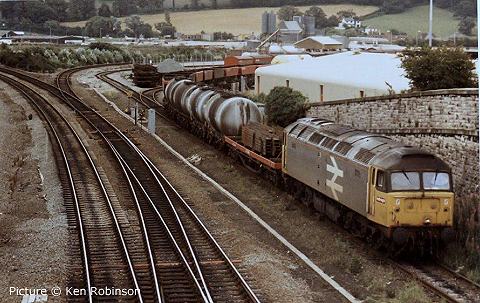
Many thanks to Ken Robinson for this picture of an Railfreight-Grey Class 47 on the North Wales Coast 'Speedlink' service shunting Glan Conwy freight depot on 14 August 1987 in its short-lived heyday. It was taken from the almost exact position on Queen's Road bridge as the picture of 67 009 in the last issue [repeated below].
There is a fine assortment of wagons in view: TTA tanks, HEA domestic coal hoppers, air-braked vans,at least 10 air-braked vans, and what might be a couple of cement wagons. This train ceased to run, along with the rest of the Speedlink wagon network, in 1991. Ken notes: 'How things have changed - it's incredible to think that this photo will be 25 years old this August!'
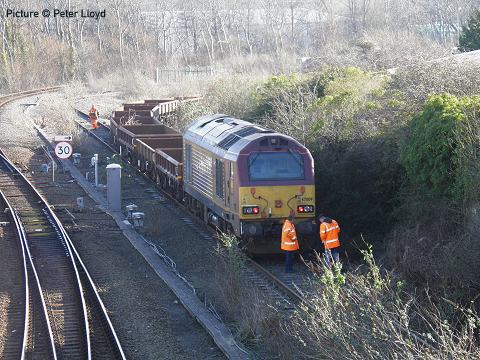
Also noticeable is that the small yellow 'cut-out sign' for the speed-restriction round the sharp curve to the Conwy Valley, just visible in the 1987 view, has been replaced by a large reflective version.
67s to Bangor
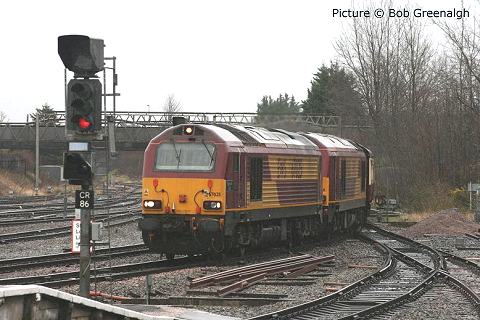
67 025 Western Star and 67 026 headed UK Railtours' Euston - Bangor charter on 18 February. Above, the train runs into Chester at 09:59, a minute early (Bob Greenalgh).
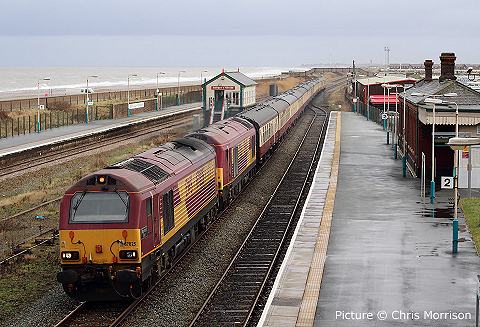
Abergele (Chris Morrison).
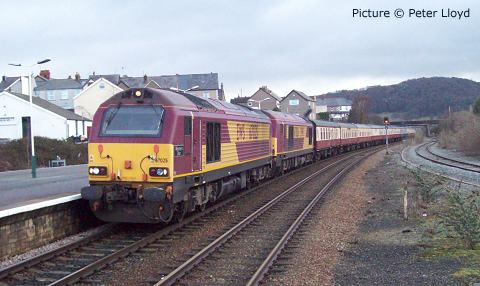
Llandudno Junction (Peter Lloyd). Note the de-forested track on the right leading to the freight depot - see last issue.
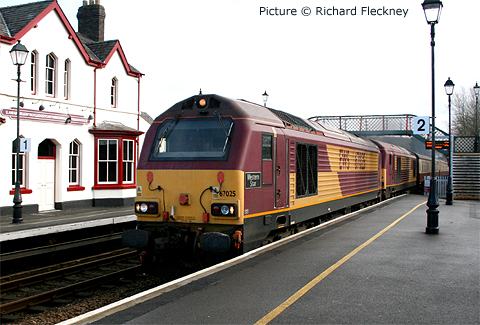
Llanfair PG (Richard Fleckney).
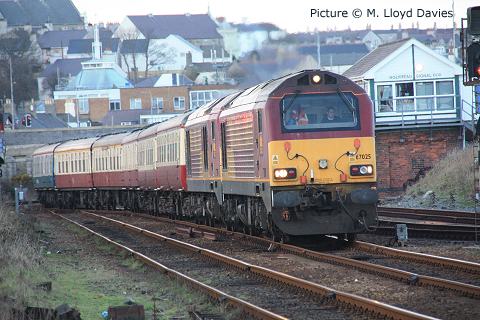
From Bangor the passengers visited the Welsh Highland Railway while the train went to Holyhead for servicing. Above, in fading light, it departs Holyhead for Bangor to collect them for the return to London.
The story of 80042 - by Charlie Hulme
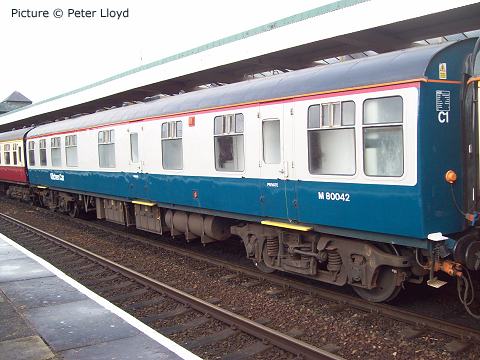
A particularly interesting vehicle in the 18 February charter consist was M 80042, photographed (above) by Peter Lloyd at Llandudno Junction. It was built c. 1960 by British Railways as Buffet Restaurant Car no. 1646 with a kitchen, buffet bar and passenger seating. Note the door with its small extra opening flap to facilitate loading of supplies, a feature of BR Mk 1 catering cars.
It was rebuilt by FM Rail in 2006 with additional kitchen facilities replacing the seating, re-numbered in the BR Kitchen Car series, and used by FM Rail in their ambitious 'Blue Pullman' project which was launched in a blaze of publicity.
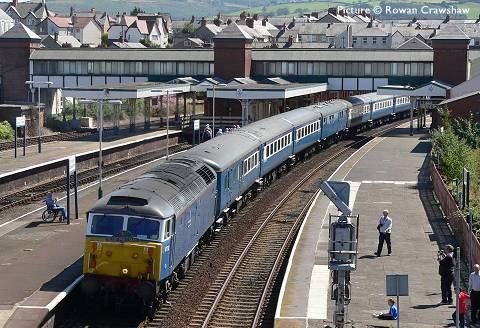
The train visited North Wales on 15 July 2006, was photographed at Llandudno Junction, with loco 47 712 at the head, by Rowan Crawshaw (above, from our archive) showing the livery which was said to replicate the 'Nanking Blue' used on the legendary Midland Pullman of fond 1960s memory. 80042 is the fourth coach in the train Unfortunately, soon afterwards FM Rail collapsed into bankruptcy and the Blue Pullman train was sold to Cotswold Rail, which itself became history in 2009. Meanwhile 80042 saw some service with DRS in their 'Stobart Pullman' train - yet another short-lived luxury train operation, not helped in its marketing by the plastering of the train with garish 'Stobart' logos (here's a picture). before being sold to Cargo-D, which painted it in their favourite colour scheme - 1960s British Rail corporate blue and grey - which it retains at the time of writing.
Worse was to come: 80042 was Cargo-D's only serviceable catering vehicle suitable for all-dining trains, and in Summer 2011 it had to be taken out of service due to a mechanical problem with one of the bogies, several promised charter trains were cancelled at short notice, and soon yet another small rail company was in the hands of an Administrator who was selling off its assets. 80042 is now in the fleet of Riviera Trains, which may well be the longest survivor of the small train-hire firms which sprung up after privatisation, thanks partly to their contract with EWS - and now DB Schenker - to supply coaches for charter trains.
Riviera also own sister vehicle 80041, also a conversion from a Buffet Restaurant (1690); none of the 40 original BR Kitchen Cars 80001 - 80040 remains in service.
NMT on the coast
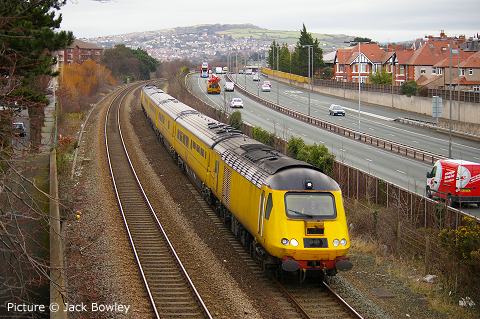
The HST-based New Measurement Train of Network Rail made a foray to Holyhead on 16 February. Above, the outbound run at Colwyn Bay (Jack Bowley)
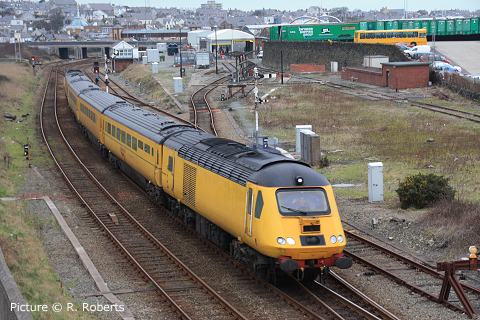
Above, it departs Holyhead on the return run (R. Roberts). The locos were 43 013 and 43 014.
On the Dee Bridge
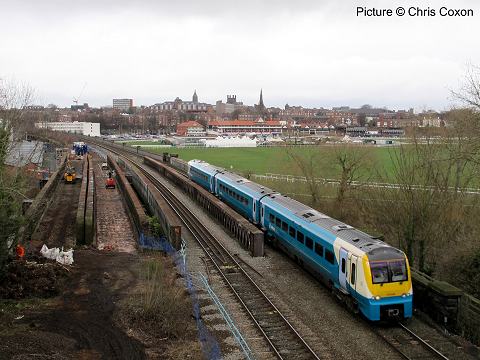
As reported here before, the Dee viaduct is getting a facelift. Above, 175 104 crosses the bridge on 13 February, having passed the viaduct site compound, associated with the Network Rail works to significantly strengthen structural steelwork, grit-blast, and paint the structure. (Chris Coxon)
The first railway bridge here was opened in 1846 and partially collapsed the following year while a train was crossing, to the detriment of engineer Robert Stephenson's reputation. It used cast-iron beams, an inherently weak concept, but was repaired and strengthened, being replaced in 1871 by a two-track girder structure, later widened to allow Wrexham line trains an independent double-track route. The extra tracks were abandoned c. 1980 - possibly also the last time the remaining structure was repainted.
A trip on the Rugby Express - report and pictures by Adam Barnard
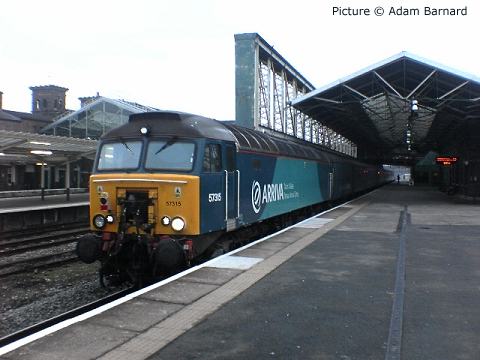
On Sunday 12 February, Arriva Trains Wales ran additional trains from Holyhead to Cardiff in light of the Rugby taking place at the Millennium Stadium, including the 06:50 Holyhead-Cardiff and 19:55 return that was worked by 57 313 and 57 315 top-and-tailing six mark 2 coaches. Two locomotives were necessary as the train ran via Wrexham General (reverse) and not Crewe. Above: 57 315 at Chester, having worked the train forward from Holyhead.
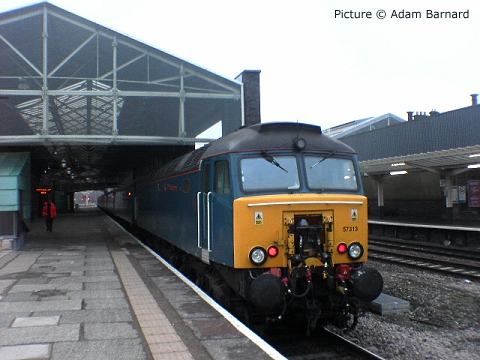
Above: 57 313 at Chester on the rear (soon to be the front) of the Rugby Express.
I was on the train from Bangor to Shrewsbury. It arrived into Bangor on time with about three people on it. Around 12 people including myself boarded at Bangor. A few people joined the train at Llandudno Junction, Rhyl, Prestatyn, and Chester (where the train waited for half an hour), before a large number of people joined the train at Wrexham General, up until which I had a coach to myself. Arrival into Shrewsbury (below) was on time.
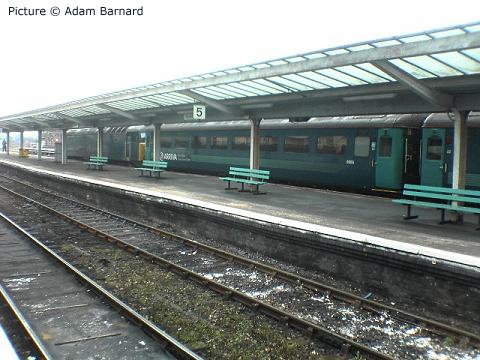
The calling pattern of the train was Holyhead - Bangor - Llandudno Junction - Rhyl - Prestatyn - Chester - Wrexham General - Shrewsbury - Leominster - Hereford - Abergavenny - Pontypool & New Inn - Cwmbran - Newport - Cardiff Central. I asked a member of the train crew about the odd stopping pattern of the train and why some major stops such as Flint and Ludlow were omitted, and he didn't know, and it seemed as if management had just selected 'some' stations to serve.
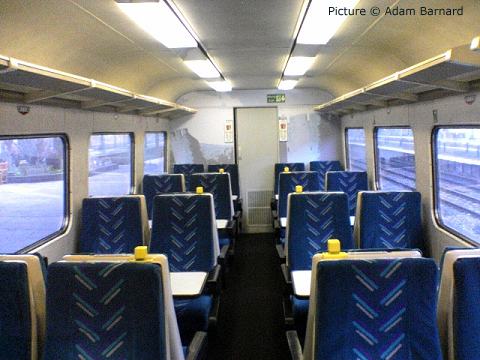
Overall, it was a very nice trip and a good opportunity to see Class 57s and Mark 2 coaches in use before they are (apparently) replaced by Class 67s and Mark 3 coaches later this year. The picture shows the interior of the Mark 2 BSO (Brake Standard Open) carriage that I had to myself as far as Wrexham.
Saturday Pendolino
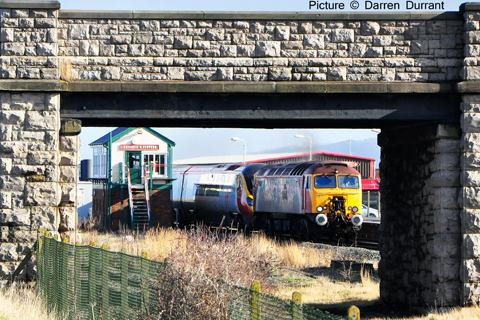
57 302 Virgil Tracy worked the Saturday 'Pendolino drag' on 18 February. Picture at Abergele by Darren Durrant (see Also Darren's YouTube channel)
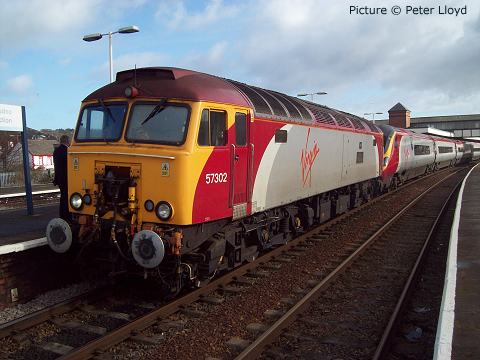
Arrived at Llandudno Junction (Peter Lloyd). The Pendolino was 390 006 Virgin Sun.
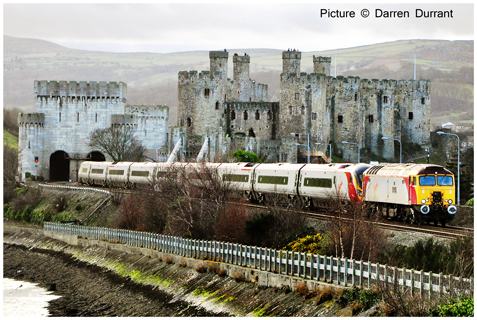
The afternoon train to London passes Conwy (Darren Durrant)
Worth Valley steam - report by Alan Crawshaw
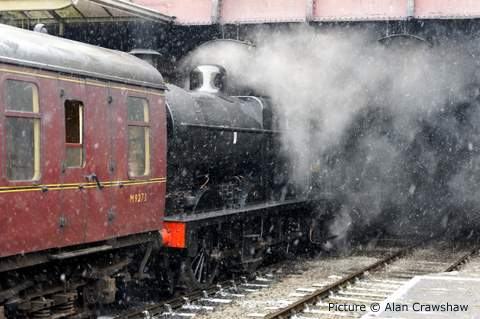
Rowan and I called in on the Keighley and Worth Valley Railway winter steam gala on our way to York on Friday 10 February, the 07:22 from Bangor and connections at Chester, Manchester and Leeds getting us there by late morning. Our first sight was of the Midland Railway 4F 43924, the first locomotive to be rescued from Barry scrapyard. The snow soon stopped, but the icy weather caused a few cancellations and late running.
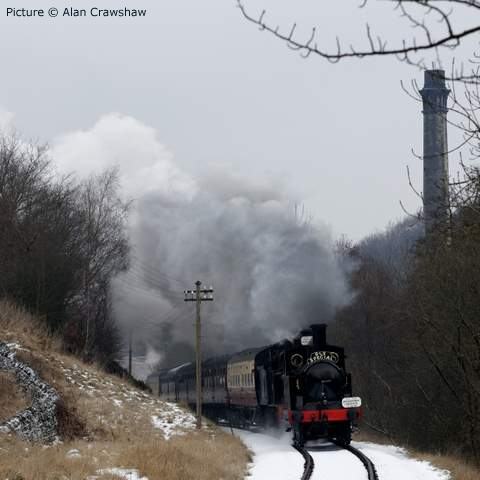
The last train from Abergavenny to Merthyr ran on 5 Jan 1958, hauled by Webb coal tank 58926 and 'Super D' 49121. 49121 was later scrapped but 58926 was saved by a group of enthusiasts led by Max Dunn, former Bangor shedmaster; see also the 3 Oct 2011 Notice Board. The locomotive is now owned by the National Trust. Following the recent restoration and repainting into BR livery of the coal tank, the Keighley and Worth Valley Railway staged a re-creation of the last train with the only surviving 'Super D' 49395 running as 49121.
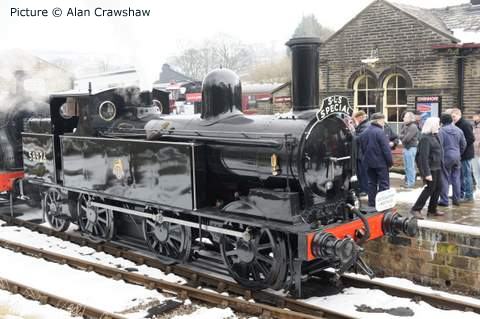
The train is seen here at Oxenhope. The same pair are billed to appear at the Llangollen 'Steel, Steam and Stars III' gala in April, during which another re-enactment of this last train is planned.
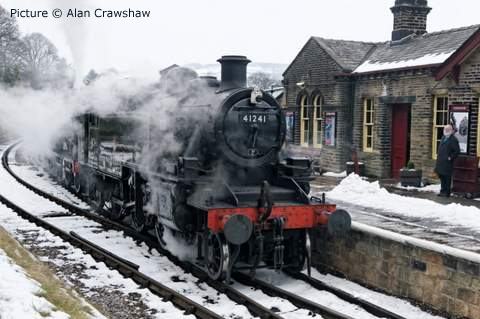
Finally we see Ivatt 2-6-2T 2MT 41241 at Oxenhope. Built by BR in 1949 to an an LMS design, it was allocated at Bangor and Llandudno Junction sheds for a period in the 1960s.
Also 'out to play' was the wonderful Lancashire & Yorkshire Railway No. 957 (built in Manchester in 1887 by Beyer Peacock) to complete a superb quintet of locomotives from the LMS and its constituent companies.
Electro-Diesels on the Wirral - report by Stavros Lainas
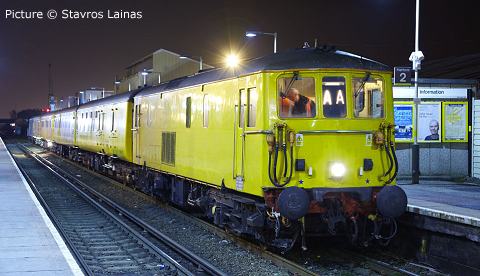
Some nocturnal views of measurement train 2Q78 Wigan - Hooton on 14 - 15 February. Class 73 electro-diesel locos (originally built for use on the Southern Region) are used as they can run from the electric third rail where available to avoid polluting the tunnels, and on their diesel engines elsewhere. Above, the train in Ellesmere Port station at 23:54 at with 73 138 leading.
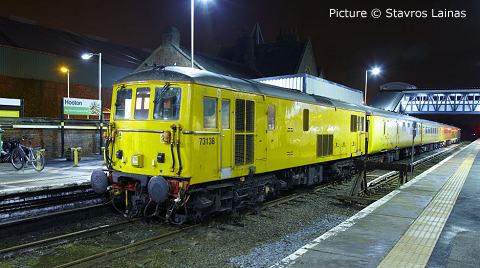
Hooton, with 73 138 at 00:08 ...
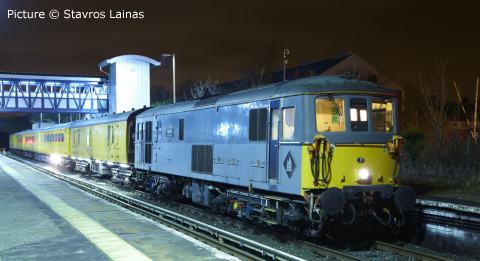
... and on the other end of the train, 73 107 taken at 00:12 just before an announcement that the station was closing.
Stone on the coast
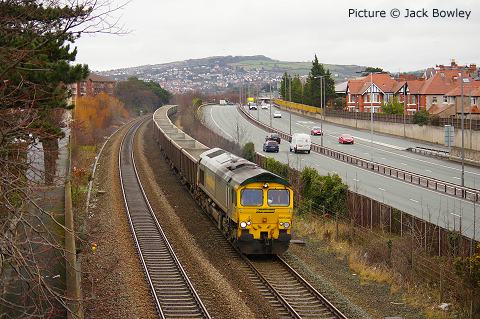
Another load of ballast was dispatched from Penmaenmawr Quarry to Guide Bridge on 13 February: above, 66 548 brings the empty wagons through Colwyn Bay in the morning (Jack Bowley).
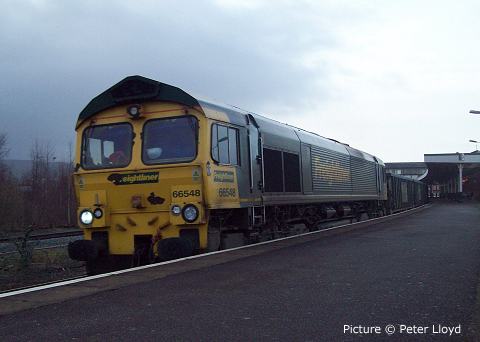
The return working, 6H45, Penmaenmawr - Guide Bridge, with 22 loaded wagons passing Llandudno Junction at 15:41, 97 minutes late (Peter Lloyd).
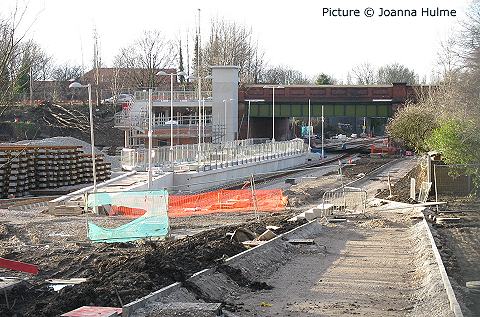
Where some of the stone ends up - East Didsbury station, Manchester Metrolink under construction, seen on 19 February (Joanna Hulme). This will be the terminus of the 'South Manchester' line, which is laid on the trackbed of the former Midland Railway main line. Beyond here, off the scene to the left, cuttings have been filled in and river bridges removed, although a plan exists to continue to Stockport in the future. The Trans-Pennine Trail shares the route at this point; a new path for it is seen under construction on the right.
Chester Goods Shed update - by John Murray
Chester Civic Trust have objected to the demolition (see the planning application) of the Chester Enterprise Centre, opposite the station, which was severely damaged by fire in December 2010 (see our 7 December 2010 issue).
The Enterprise Centre building was built as a railway goods station. It is a fine example of late-nineteenth century functional railway architecture. The Trust understands that, despite fire damage, the structure is sound and that there are no grounds for demolition for reasons of safety or lack of structural integrity.
Chester Civic Trust therefore objects to the proposal to demolish on six
grounds:-
1. The structure forms part of the heritage ensemble of buildings at Chester General Station and planning for this site needs to be considered within this context. It is not just another development site.
2. The Railway Station Partnership needs to be directly involved in formulating proposals for this site.
3. The building, though not listed, has architectural quality, was strongly built and its fundamental structure remains sound.
4. The case for demolition appears to rest on short-term financial considerations.
5. The structure is potentially adaptable to a number of potential uses.
6. No consideration appears to have been given to alternative uses for the structure. With the failure of the West Car Park scheme at the Station, a feasibility study is needed to consider the potential for this structure and site to be converted into the much-needed additional car-parking at the station. This could be in conjunction with a new pedestrian bridge to the station area. There is a regional precedent in the conversion of the Great Northern Warehouse adjacent to the former Manchester Central Station (G-Mex).
The One City Plan identifies this area as a key gateway point into the city .... under-utilised at present (BQ4 City Centre North Gateway). An imaginative approach is needed to this structure and site and until this is developed we oppose demolition of the current structure.
English Heritage have become involved, but their reply to the Council Planners, dated 13 February, states that they do not wish to comment on the application and the future of the building should follow local and national policy.
Back in December, a Network Rail spokesman told the Chester Chronicle that 'within days of the accidental fire officers from the Council and Chester Renaissance were informally suggesting the site as an alternative location for its proposed multi-storey car park but this was flatly denied.'
Personally, I want to see the structure remain and re-used for another purpose.
Mawddach moments
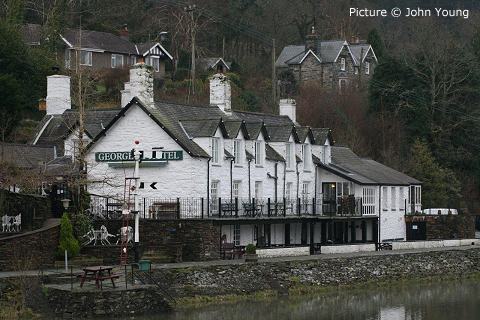
John Young writes of having had 'a super weekend' at the George III Hotel at Penmaenpool after reading about it here. It's a place with a fascinating building with an interesting history. The railway from Morfa Mawddach to Dolgellau, opened in the 1860s, and ran along the stone embankment at on the edge of the Mawddach estuary; it closed in 1964 and is now an excellent walking and cycling trail. The main hotel building, however, is a much older building, said to date from 1650, which as a hotel in 1890. John's picture above is taken from the road toll bridge which crosses the estuary at this point, being the lowest road crossing of the river.
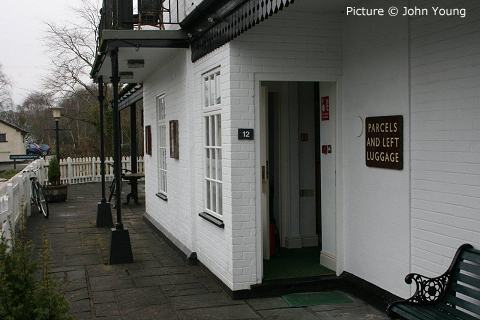
The former Penmaenpool station building, pictured above by John Young, is a typical Cambrian Railways structure just a short walk from the main hotel, and has been taken over by the hotel and now comprises several en-suite rooms. The nearest open station is Morfa Mawddach, about four miles away, but buses which run near Fairbourne station call on the nearby road.
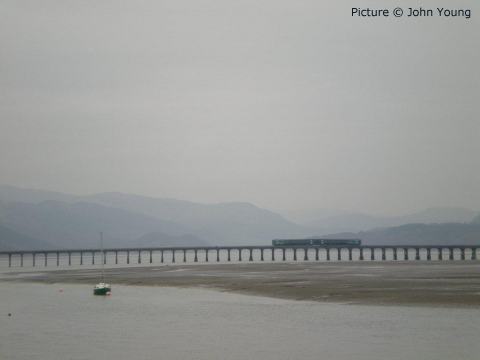
The view from Penmaenpool as 158 837 makes is way across Barmouth bride (John Young)
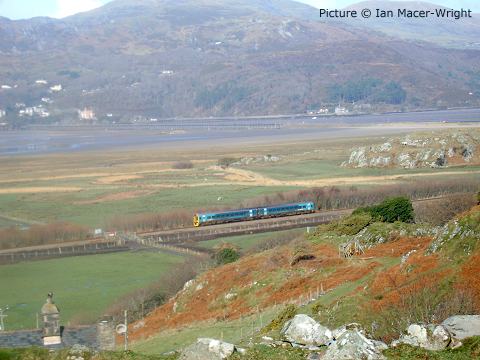
A view by Ian Macer-Wright from the hillside above Fairbourne, with Barmouth Bridge in the distance, showing the lack of trees; a number have been cleared over the last few weeks.
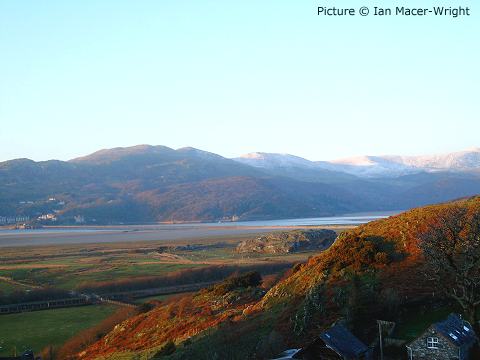
The same scene at sunset (Ian Macer-Wright).
How many Class 92s per Wind Turbine?
The following rather contrived press release comes from DB Schenker:
DB Schenker Rail UK has outlined plans to introduce carbon-free rail freight services for customers using trains hauled by electric locomotives, further improving the environmental credibility of rail freight.
Working with Renewable Energy Systems (RES), one of the world's largest renewable energy developers, DB Schenker Rail UK is proposing to build three wind turbines on its land at Margam, near Port Talbot in South Wales, to provide renewable energy to the rail network. RES is currently in discussions with Neath & Port Talbot Council regarding the scheme.
The energy generated by the turbines would be enough to power a 'green fleet' of DB Schenker Rail UK's Class 92 electric locomotives. The electricity would be sold to Network Rail for use in the overhead power cables and in doing so, DB Schenker Rail UK will be able to offer customers 'carbon-free' rail freight services in the UK by the end of the year.
Alain Thauvette, Chief Executive of DB Schenker Rail UK, said: "Deutsche Bahn wishes to reduce its carbon emissions by 20% by 2020. This proposal is a significant step forward in delivering this carbon reduction target in the UK, while enabling DB Schenker Rail to provide its customers with Eco Solutions to reduce their carbon emissions."
Mr Thauvette continued: "We hope that the local authority and the Welsh Assembly Government will support the development, which would see carbon-free freight trains operating to Wales when routes are electrified."
Carbon-free freight trains would operate from London to Scotland on the West and East Coast Main Lines and to Wales on the Great Western Railway once that route is electrified. RES and DB Schenker Rail will submit their proposals for planning approval during the spring.
[We have inserted the old-fashioned hyphens in 'carbon-free' in the home of making the thing readable.]
North Wales Coast home page Archive Previous Noticeboard